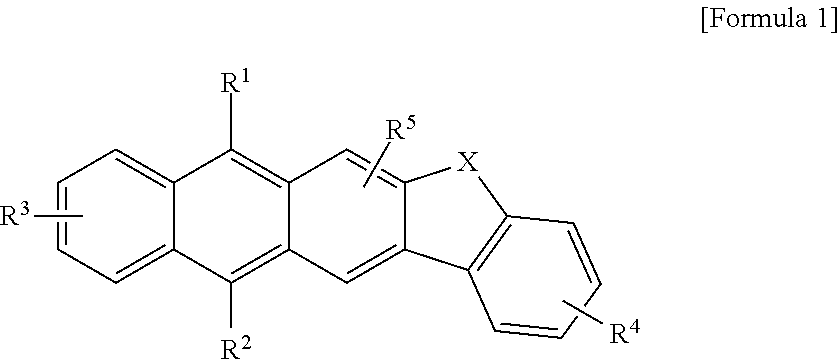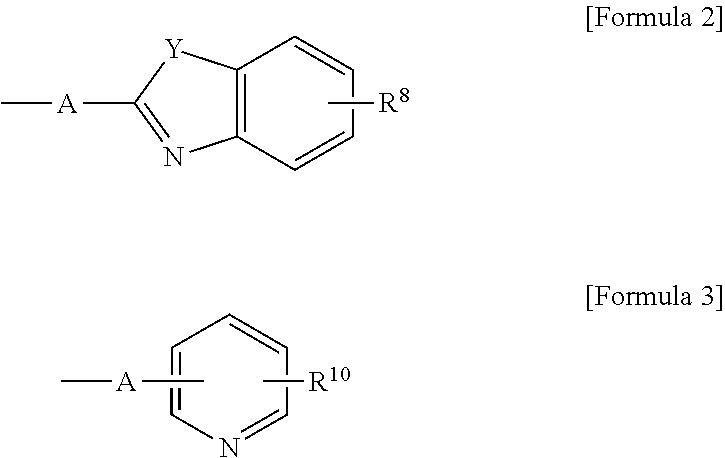Anthracene derivative and organic electroluminescence element using the same
an anthracene derivative and organic technology, applied in the direction of luminescent compositions, organic chemistry, thermoelectric devices, etc., can solve the problems of low thermal stability of tpbi for actual application to a device, not yet put to practical use in view of driving voltage, luminance, device lifetime, etc., to improve the performance and lifetime of an organic light emitting device, and the effect of high electron transport capability
- Summary
- Abstract
- Description
- Claims
- Application Information
AI Technical Summary
Benefits of technology
Problems solved by technology
Method used
Image
Examples
synthesis example 1
Preparation of 2-bromo-9,9-dimethyl-9H-fluorene
[0045]2-bromo-9H-fluorene (44.1 g, 0.18 mol) was placed in a flask (1 L), and dimethylsulfoxide (500 ml) was added thereto. Then, KOH (94.25 g, 1.443 mol) dissolved in distilled water (20 ml) was added. At 0° C., Iodomethane (76.85 g, 0.541 mol) was gradually dropped, and the reaction mixture was stirred at room temperature. After the reaction was terminated, the reaction solution was added to distilled water (1 L). After stirring for 30 mins, the resultant solid was filtered, and purified by column chromatography to provide 2-bromo-9,9-dimethyl-9H-fluorene (34 g, yield=96.9%).
[0046]GC-Mass (theoretical value: 272.02 g / mol, measured value: 272 g / mol)
synthesis example 2
Preparation of 2-(7-bromo-9,9-dimethyl-9H-fluorene-2-carbonyl)benzoic acid
[0047]2-bromo-9,9-dimethyl-9H-fluorene (40 g, 0.146 mol) and phthalic anhydride (23.8 g, 0.161 mol) were placed in a reaction vessel and dichloromethane (1 l) was added thereto. Then, aluminum chloride (29.2 g, 0.219 mol) was gradually added at 0° C., and the reaction mixture was stirred at room temperature for 12 hours. After the reaction was terminated, distilled water was gradually added, and the reaction solution was extracted with dichloromethane and 3 times washed with distilled water. After solvent removal, the resultant solid was placed in a hexane(2 l)-containing vessel, washed, filtered and dried to give 2-(7-bromo-9,9-dimethyl-9H-fluorene-2-carbonyl)benzoic acid (50.4 g, yield 82%).
[0048]1H-NMR (500 MHz, THF-d8): 8.44 (t, 1H), 8.23 (d, 1H), 7.96 (m, 6H), 7.72 (m, 5H), 7.55 (t, 1H), 1.67 (s, 6H).
synthesis example 3
Preparation of 2-bromo-13,13-dimethyl-6H-indeno[1,2-b]anthracene-6,11(13H)-dione
[0049]2-(7-bromo-9,9-dimethyl-9H-fluorene-2-carbonyl)benzoic acid (20 g, 0.061 mol) was placed in a flask, and polyphosphoric acid (50 ml) was added thereto. The mixture was heated at 130° C. for 2 hours and cooled to less than 50°, and distilled water was gradually added thereto. The resultant solid was filtered, washed with a small amount of methanol, and dried to give 2-bromo-13,13-dimethyl-6H-indeno[1,2-b]anthracene-6,11(13H)-dione (16.6 g, yield=81%).
[0050]1H-NMR (500 MHz, THF-d8): 8.29 (t, 2H), 8.09 (s, 2H), 7.85 (d, 2H), 7.72 (m, 3H), 1.67 (s, 6H).
PUM
 Login to View More
Login to View More Abstract
Description
Claims
Application Information
 Login to View More
Login to View More - R&D
- Intellectual Property
- Life Sciences
- Materials
- Tech Scout
- Unparalleled Data Quality
- Higher Quality Content
- 60% Fewer Hallucinations
Browse by: Latest US Patents, China's latest patents, Technical Efficacy Thesaurus, Application Domain, Technology Topic, Popular Technical Reports.
© 2025 PatSnap. All rights reserved.Legal|Privacy policy|Modern Slavery Act Transparency Statement|Sitemap|About US| Contact US: help@patsnap.com



